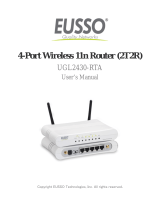Table of Contents
1. Terminology..............................................................................................................5
2. Introduction..............................................................................................................7
2.1 Package Content.............................................................................................7
2.2 Product Features............................................................................................7
2.3 Rear Panel Description..................................................................................8
2.3 Front Panel Description ................................................................................9
3. Hardware Installation ...........................................................................................10
3.1 Appearance and Interface Introduction....................................................10
3.2 Hardware Installation Steps .......................................................................12
4. Software Configuration.........................................................................................14
4.1 Prepare your PC to configure the Access Point........................................15
4.2 Connect to the Access Point........................................................................16
4.3 Management and configuration of the Access Point ................................16
4.3.1 Wizard................................................................................................16
4.3.1.1 Bridge Mode........................................................................16
4.3.1.2 Gateway Mode.....................................................................21
4.3.1.3 WISP Mode .........................................................................30
4.3.2 Operation Mode................................................................................41
4.3.3 Internet Settings................................................................................43
4.3.3.1 WAN........................................................................................43
4.3.3.2 LAN.........................................................................................48
4.3.3.3 VPN Passthrough...................................................................49
4.3.4 Wireless Settings ...............................................................................50
4.3.4.1 Basic ........................................................................................50
4.3.4.2 Advanced ................................................................................52
4.3.4.3 Security ...................................................................................54
4.3.4.4 Site Survey..............................................................................61
4.3.4.5 WPS.........................................................................................62
4.3.5 Firewall ..............................................................................................63
4.3.5.1 MAC/IP/Port Filtering ..........................................................63




















